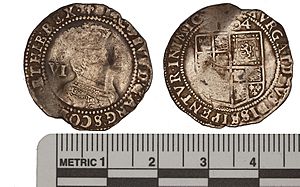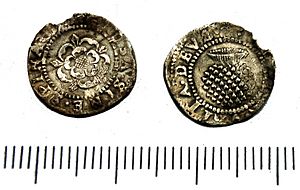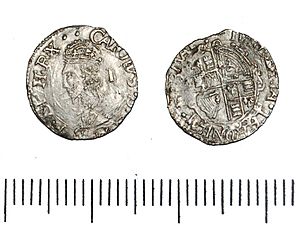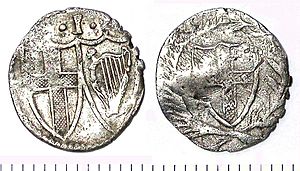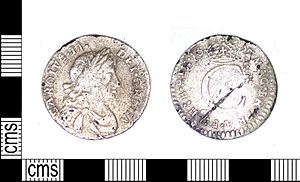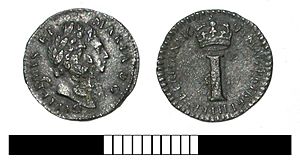History of the English penny (1603–1707) facts for kids
This article tells the story of the English penny coin between 1603 and 1707. This time was ruled by the House of Stuart family. It also includes the important moment when England and Scotland joined together in 1707.
Contents
Pennies of the Stuart Kings (1603–1714)
King James I and His Pennies
In 1603, Queen Elizabeth I passed away. The throne went to James VI of Scotland, who became King James I of England. His silver coins were much like Elizabeth's.
A new copper farthing coin was made to help with small change. The penny became less important because prices were going up.
The first pennies from 1603–1604 showed King James's face. The words on the coin meant "James by the grace of God, a rose without a thorn." The back showed a shield with the Scottish coat of arms.
Later pennies (1604–1619) had a rose on the front instead of the king's face. The back showed a thistle, which is a symbol of Scotland. The words on the back meant "May God guard these united (kingdoms)." All these coins were made in the Tower of London.
King Charles I and Civil War Coins
In 1625, Charles I became king. He had many disagreements with the Parliament of England. This led to the English Civil War. This war eventually cost Charles his throne and his life.
Charles I's reign was very interesting for coins. Many different types of pennies were made. New mints (places where coins are made) opened during the Civil War. These mints made coins to pay soldiers. They mostly made larger coins, so fewer pennies were produced.
A Frenchman named Nicholas Briot made some very high-quality pennies using machines. These were called "milled" coins.
Early pennies made at the Tower of London had a rose on both sides. The words on the front meant "Charles by the grace of God, a rose without a thorn." The words on the back meant "Justice strengthens the throne."
Later pennies showed the king's face and the number "I" to show it was one penny. The words meant "Charles by the grace of God King of Great Britain France and Ireland." The back had a shield and the words "Justice strengthens the throne."
When Parliament took control of the Tower mint in 1642, they kept making these coins. They used an older-looking picture of the king. This was to show they were fighting his "bad advisors," not the king himself.
Mints During the Civil War
In 1638, a new mint opened at Aberystwyth castle in Wales. It made smaller coins from local silver. These coins had plumes (like feathers) on the back.
During the war, King Charles I set up his main mint in Oxford. Most pennies made there looked like the Aberystwyth coins. A very rare "Declaration penny" from 1644 had a special message on the back. It said "The religion of the Protestants, the laws of England, the liberty of Parliament." The Oxford mint closed in 1646.
Bristol and Exeter also had mints during the Civil War. Bristol made pennies with the plume design. Exeter mainly made larger coins, but also some pennies.
Commonwealth Pennies (1649–1660)
After the Civil War, England became the Commonwealth of England. This was a time without a king. The coins made during this period are special because they did not have any Latin words. This was because Latin was linked to Catholicism, which the Commonwealth leaders did not support.
The Commonwealth penny had no words at all. The back showed St George's shield inside a wreath. The front showed St George's shield and an Irish shield, with the number "I" above them for one penny.
The Restored Kings and Milled Coins
In 1660, the monarchy returned with Charles II. Both old-style "hammered" coins and new "milled" coins were made at first. The penny was a common coin.
The hammered pennies showed the new king's face. The words meant "Charles II by the grace of God King of Great Britain France and Ireland." The back showed the king's shield over a cross. The words meant "I reign under the auspices of Christ." These were the last hammered pennies. All English coins after this were made by machines (milled).
The first regular milled silver pennies appeared around 1664 or 1665. They were small, weighing about 0.5 grams. They showed the king's face and the number "I" for one penny. The back had a shield with the Arms of England, Scotland, Ireland, and France.
From 1670 to 1684, pennies were made every year with the date. They showed the king's face and the words "Charles II by the grace of God." The back showed a crowned "C" (for Charles) and the words "King of Great Britain France and Ireland [date]."
James II and William and Mary
The same design continued for James II (1685–1688). The crowned "C" on the back was changed to a crowned "I." This "I" stood for "Iacobus" (Latin for James) and also for 1 penny.
After James II, the throne was offered to his daughter Mary and her husband, William III of the Dutch Republic. They ruled together as William III and Mary II (1689–1694). Their silver pennies showed both their heads. The words meant "William and Mary by the grace of God." The back still had the crowned "I" for the penny. The words meant "King and Queen of Great Britain France and Ireland [date]."
After Queen Mary died in 1694, the coins showed only King William's head. The words meant "William III by the grace of God." The back still had the crowned "I" and the words "King of Great Britain France and Ireland [date]." Pennies were made from 1698 to 1701.
Anglo-Scottish Union and Queen Anne
In 1702, Queen Anne became ruler. During her reign, the kingdoms of England and Scotland joined together in 1707. This created the Kingdom of Great Britain.
Queen Anne's reign produced silver pennies in many years, like 1703, 1705, and 1708. The front of her coins showed her face. The words meant "Anne by the grace of God." The back showed the crowned "I" for one penny. The words meant "Queen of Great Britain France and Ireland [date]."
The Stuart dynasty ended with Queen Anne in 1714. The crown then passed to George I, from the House of Hanover family.


